Paris – The Hidden Gems
DAY 1
The covered passages of Paris make it possible to walk while visiting the shops sheltered from the mud and the anarchic traffic of the street.
Before the great transformations carried out under Napoleon III by the prefect Haussmann, between 1852-1870, most of the streets were in clay (no paving stones) and no sidewalks. During the French Revolution (1789), the properties of religious people and emigrants were put on sale, and commercial buildings were created generating significant income.
The covered passages were created by wealthy bourgeois to promote trade without opening additional streets, which would take up space without generating profits. There were more than 40 passages in Paris. This section offers a walk through the covered galleries still existing in the 9th and 2nd district of Paris. These are the passages Verdau, Jouffroy, Panoramas, Princes, Vivienne, Colbert, and Choiseul.
If you are traveling by subway, which is the most convenient way, the best is to go to Metro Cadet, line 7 and follow our itinerary.
Most passages are private and are closed at night by gates or doors (usually from 8pm to 8am) and on Sundays.
They are generally classified as historical monuments since 1974, but it is the owners who are in charge of maintaining them. IDurand comme


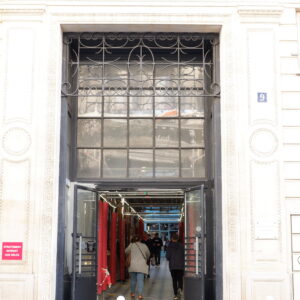

LE PASSAGE VERDEAU
Take rue Cadet and turn in rue du Faubourg Montmartre, the Verdeau passage is just slightly on your left, on the other side of the road, at number 31 of the street. The glass rooftop makes the passage very luminous and the canopy is divided in in two parts allowing a circulation of air which prevents that the passage becomes an oven during the beautiful days. The passage houses many antique dealers and art dealers as well as restaurants.

LE PASSAGE JOUFFROY
Leaving the Verdeau passage, you just have to cross the street to find yourself in the passage Jouffroy built at the same time in 1847. This is the first passage entirely built in metal. This covered walkway is known to house the Musée Grévin, a wax museum that was inaugurated on January 20, 1882. Next to it,the hotel Chopin dates from the 19th century and it has its entrance directly in the passage. Where the passage overlooks the Rue de la Grange Batelière, the ground was not wide enough to allow 2 rows of shops. There is only one side of shops, with a boutique setting with just the showfront opposite.
LE PASSAGE DES PANORAMAS
One of the first passage to be opened in Europe in 1799 and to experience gas lighting in 1816, you just have to cross the boulevard Montmartre to enter it. The Passage des Panoramas is one of the most beautiful and lively in the capital. A popular place to walk since the 19th century, it is a Parisian Mecca of the trade of stamps for collection. The passage has the particularity of opening on small adjacent galleries. The passage takes its name from the attraction presented by the American inventor Robert Fulton. He financed his inventions (the steamboat, the submarine Nautilus and the torpedo), which he presented in Paris in an exhibition located in 2 rotundas and presenting panoramas of landscapes of Paris, Toulon, Rome.


LA GALERIE COLBERT
It is one of the two most beautiful galleries of the capital with the Vivienne gallery. Its entrance is at 6 rue des Petits Champs, The gallery dates from 1826. It feels like entering a university building rather than a passage. This gallery was indeed bought by the B.N.F. and now houses the National Institute of Art History and the National Institute of Heritage. It is however free to access. though: a guard is at the entrance and opening hours are very limited. We could not get in there. In the center of the rotunda stands a bronze statue representing Eurydice, the wife of Orpheus.
LA GALERIE VIVIENNE
Inaugurated in 1826, the Galerie Vivienne imposes on the visitor its beauty with its elegant glass roof, the intricate pattern of its mosaic floor and the richness of its decor. The Vivienne gallery is the second longest in this presentation. It consists of several sections separated by steps.Today, it houses ready-to-wear and decorative items. The gallery is elegant all along, it seems quite uncrowded on weekends, the neighborhood comes alive especially during the week. The dome is one of the largest in the passages, elegant and sober.
LE PASSAGE DE CHOISEUL
The passage of Choiseul overlooks the 40 rue des petits champs on one side and ends at 23 rue Saint Augustin. The gas lighting was replaced by electric balls and lamps. The passage, very busy when it opened, fell into disuse, then had a revival of activity when the couturier Kenzo settled there in the 1970s, then declined when he left.
DAY 2
Sometimes a bit of jet lag is exactly what you need on vacation to start the day bright and early and don’t lose any time. The plan for this second day is to visit the Marais and the best way to reach is to take the metro to Chatelet (line 1) and walk from there. However, is the sky is blue and the day is warm, you may consider strolling down the Champs-Elysee and found the entrance of the Jardins de Champs-Elysee. Business men and women walking and listening to music, briefcase on hand on their way to work, cafés opening, gardeners keeping up the amazing look of the park.

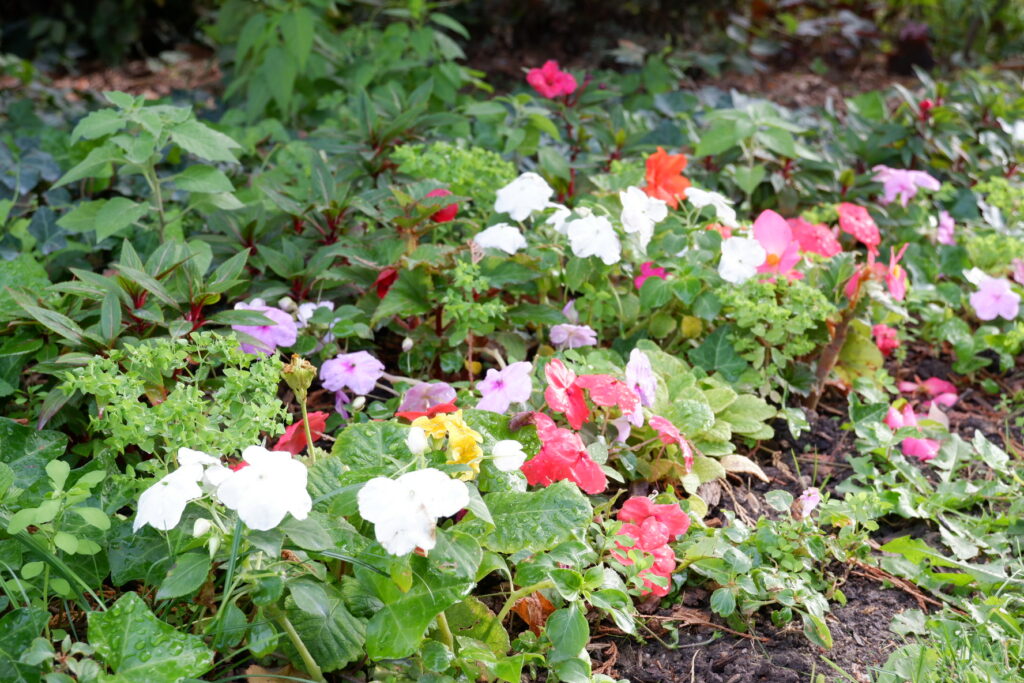
The walk will take you all the way to Place de la Concorde. The Obelisque standing still in the middle of the square busy with morning traffic deserved a look (and a picture). It’s like nothing or anyone could ever bother it. It’s there now, it will be tomorrow and in a 100 years. Continue your walk inside the Jardins des Tuileries all the way up to the Louvre. Most of you will probably been there before so you may decide to leave out the visit of the museum this time. It’s huge and it would need a whole day (or more) to be visited properly, maybe you can keep the visit for when you’ll end up in Paris in a cold winter day.


Down again into Rue the Rivoli and then towards Les Halles. Les Halles is now a big mall, but was once the spot that hosted the central market of Paris. Next to the main square there is a gothic church that will catch your attention. Like we always do when we find something interesting, you may want to walk inside. It was undergoing renovation works when we visited it, but we still got a glimpse of it. The outside is more impressive than the inside for sure, but what is special about the church (but we came to know afterwards) is that it is the church where Moliere was baptized.
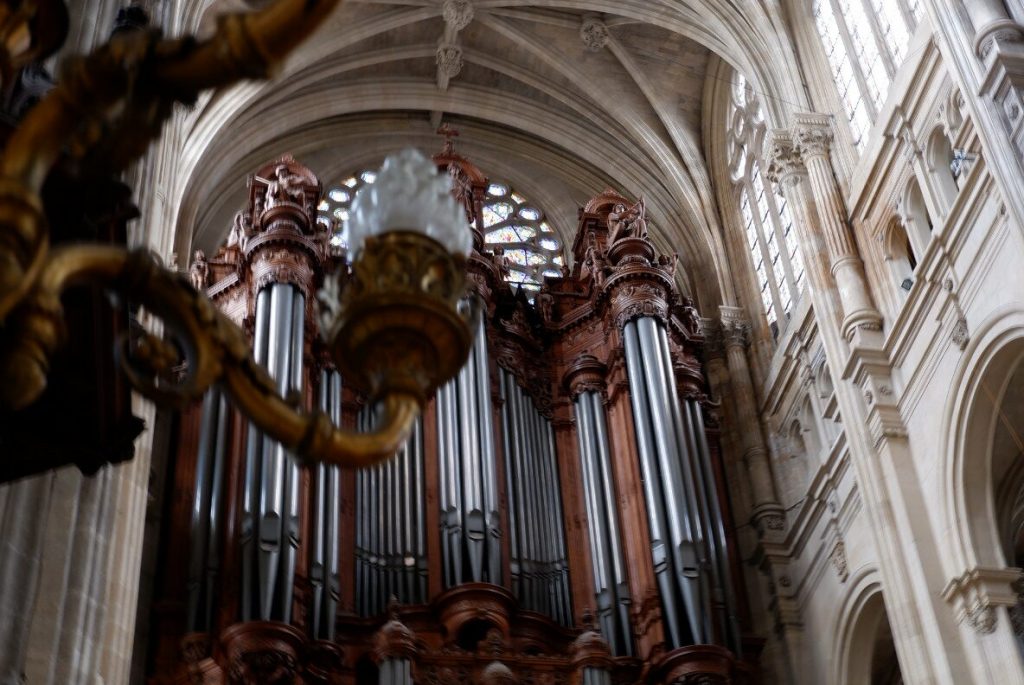

From there walk onwards towards the Beaubourg (better known as Centre Pompidou). It was designed in the style of high-tech architecture by the architectural team of Richard Rogers and Renzo Piano. It houses the Bibliothèque publique d’information, a vast public library; the Musée National d’Art Moderne, which is the largest museum for modern art in Europe; and IRCAM, a centre for music and acoustic research. Here is the link to the website, with more information on opening hours and exhibitions.


Continue your walk and will found on your way the Hotel Sully. It was briefly mentioned in our guide, so we decided to take a look at it and you definitely should do as well.


DAY 3
This itinerary will take you through Ile de la Cité and the Latin Quarter. We took the metro to Louvre-Rivoli (Line 1 and 7) and accidentally noticed at the exit of the metro station a beautiful romanic church. Saint-Germain-L’Auxerrois may not be on the touristic path, but it’s definitely worth a stop. Take Pont Neuf to Ile de la Cité, but instead of turning left on Place Dauphine, turn right and go down the staircase. At their base you’ll see the entrance to a small park (Square du Vert Galant) that covers the tip of the island. On the very tip of the island there are willows and you can see the Seine in front of you, feeling like on the bow of a boat.


Go back up and this time head to Place Dauphine and toward the Sainte Chapelle. The Sainte Chapelle was built in 1248 by orders of Luis IX to host the Crown of Thorns and transform Paris into the Catholic World Capital. While we were queuing a gentleman approached us and told us there was going to be a guided visit starting after few minutes (by the time we exited the queue had grown quite a lot. We definitely suggest to buy the tickets online and check for the free guided visits).
As the chapel for the Royals and their entourage, the Sainte Chapelle is situated in the Ile de la Cité since the Royal Palace used to be right there, before the King of France decided to move it to Versailles. The building that once hosted the Royal Palace is still there, but home to the Palais de Justice. The Sainte Chapelle consists of two different chapels.
The lower Chapel, which is the one you enter in, was meant for the servants of the palace. During the restoration (carried out 150 years ago) there was not enough information to reproduce the ceiling as it used to be, so they just copied the blue ceiling with Fleur de Lis (symbol of the French monarchy) that you can find on the upper Chapel.

Going up a steep staircase you enter the upper Chapel, once directly connected to the personal apartments of Luis IX. This Chapel was strictly reserved to the King and his small entourage. A canopy in the abse used to host 22 relics among which the only survivors are the crown of thorns, a nail and splinter of the Cross. These three until few months ago were preserved in Notre Dame, but after the fire of April 2019, they were moved in the Louvre basements.
The upper Chapel four sides are entirely made of stained glass and the weight of the structure is held by the outside pointed arches, a typical pattern on Gothic architecture. These beautifully painted windows cover an area of almost 700 sqmt and depict the whole Bible, from the Genesis to the Apocalypse which is painted on the giant rose window over the entrance.

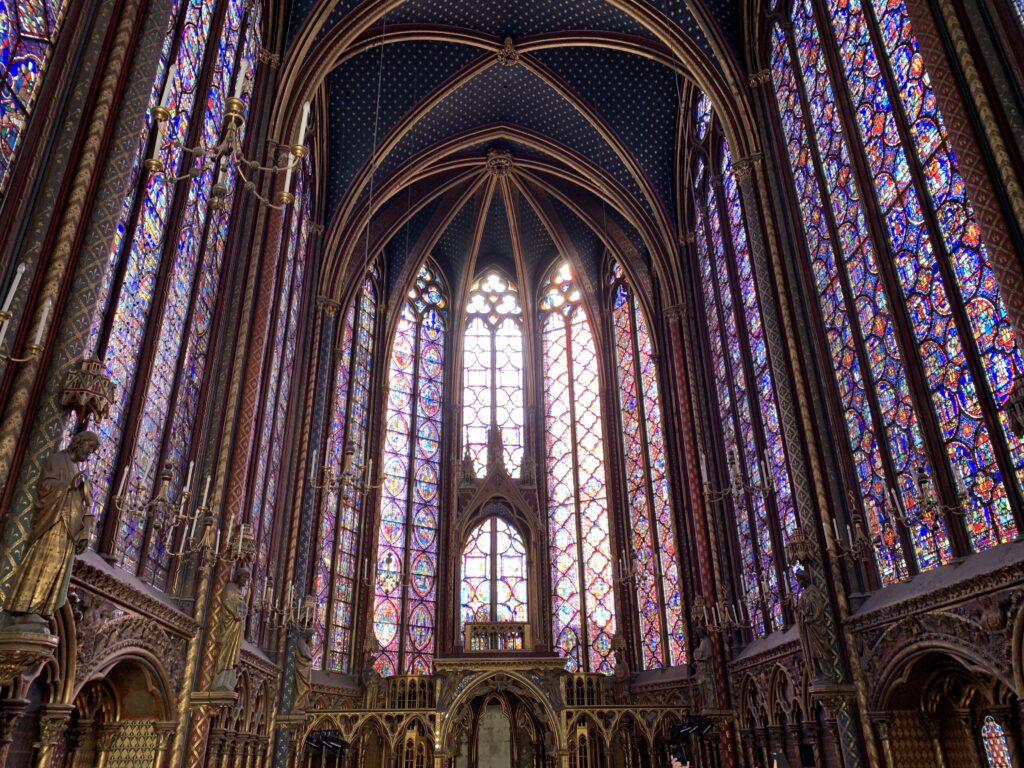


Walk then towards Notre Dame (was fenced all around when we were there and we believe it’s going to be for few more years) and take the Pont Saint Louis to stroll around in the nearby Island of Saint Louis. The entire island makes you feel like in a small French village, walking by small family owned businesses, restaurants and lovely townhouses. Stop by for lunch or a sandwich and finish off your break with a nice ice cream at Berthillon Glacier, before taking Pont de la Tournelle, towards the rive gauche.
Strolling along the riverbanks you will soon end up in the Square René Viviani, next to which there is usually a crowd gathering in front of Shakespeare and Co. This independent english bookstore was opened in 1919 and makes for a very nice stop either in the modern bookstore on the ground floor or in the old looking one on the first floor. They will stamp your books, so also a nice idea for a gift/souvenir.

Get lost in the Latin Quarter breathing the air of the artists of early 1900, and find your way towards the Eglise Saint-Sulpice. Not only this is a very nice early Gothic Church, it’s interest lays in the Paris Meridian (the Rose Line mentioned by Dan Brown in The Da Vinci Code). This brass line on the floor is part of a gnomon, a device designed to cast a shadow on the ground in order to determine the position of the sun in the sky. The sunlight passes through a small round opening in the southern stained-glass window of the transept, at a height of 25 meters, forming a small light disk on the floor; this disk will cross the meridian each time the sun reaches its zenith at true noon. The sun will cross different parts of the meridian depending the time of year. At one end of the meridian is a square marble plaque, which corresponds to the position of the sun at the highest at midday, during the summer solstice about 21 June. At the other end is an obelisk, which is lit near its top when the sun is at it lowest at midday.


Walk your way towards the Jardins de Luxemburg and take your time exploring the gardens, maybe sitting in one of the reclining chairs and enjoying the afternoon sun, before hitting the last scientific stop of the day. The Pantheon is a neo-classical building, originally a church, that hosts the tombs of Napoleon, Voltaire, Rousseau, Hugo and Zola. The queue to get inside can be quite long so we definitely advise buying your tickets online. Our main interest inside was the Foucault pendulum, a simple device named after French physicist Léon Foucault that was introduced in 1851 as the first experiment to give simple, direct evidence of the earth’s rotation. The pendulum oscillates along the same line indefinitely while the Earth rotates underneath. In a day the pendulum will have completed a full turn.
At night we enjoyed a very nice dinner at L’Absynth.
DAY 4
Get down at the metro stop Denfert-Rocherau on the line 6 to visit the Catacombs of paris. Try to be there around 9.15 to beat the crowd, the 45 min wait for the doors to open may be alleviated by a take away breakfast at the nearby Paul.


Not every inch of Paris is as romantic as you think – in fact, the Catacombs are downright chilling. Prior to the creation of the Catacombs in the late 18th century, Parisians buried their dead in cemeteries. But as the city continued to grow, burial grounds ran out of space, graves started to become exposed and stunk up surrounding neighborhoods. The limestone quarries located 65 feet beneath Paris eventually became the solution, providing ample and safe space for the city’s deceased loved ones. ones from the defunct Cimetière des Innocents were the first to arrive in 1786, when decomposing bodies started seeping into the cellars of the market at Les Halles, drawing swarms of ravenous rats. It took 12 years to move 6 million bodies from all the Parisien graves.
Today, the solemn, skull-and-boned lined tunnels weave beneath the heart of the City of Love, beckoning to visitors with an interest in the departed. The legions of bones dumped here are stacked not by owner but by type—rows of skulls, packs of tibias, and piles of spinal disks, often rather artfully arranged. Among the nameless 6 million or so are the bones of Madame de Pompadour (1721–64), laid to rest with the riffraff after a lifetime spent as the mistress of Louis XV.
The catacombs stretch for miles all over the city, but visitors are only allowed to access a mile’s worth for 45 minutes at the Denfert-Rochereau (lines 4,6 and RER B) metro station.
And because of the attraction’s unique nature and popularity, expect a queue. We went on the previous day and there was an hour (or more) wait. So we were advised by the personnel to come back the day after at 9:15 to beat the crowd. Even if some people are already queuing at that time, the doors open at 10 am and they let in 200 persons. And the wait can be alleviated by a take away breakafast and coffee from the nearby Paul’s.


The same metro line 6 will take you to canal Saint Martin (Oberkampf stop). The Canal Saint-Martin neighborhood is nestled between Gare du Nord and Republique in Northeastern Paris, in the 10th arrondissement. The canal feeds into the Seine River in the South and the Bassin de la Villette and the Canal de l’Ourq in the North.
Napoléon I ordered the construction of the Canal Saint-Martin in 1802. It was originally built to link to the Canal de l’Ourq, further north, to supply fresh water to the city. In the 19th century, the area was mostly occupied by working-class laborers. The canal and its surroundings were entirely reconstructed on set for Marcel Carné’s 1938 film, Hôtel du Nord. Only recently has it started to attract well-to-do professionals eager to take up residence in apartments with views of the canal. As a result, it’s come to be known as an area where fashion boutiques are continually springing up in the neighborhood. In the spring and summer, locals come in droves to the banks of the Saint-Martin Canal to picnic, strum guitars waterside, and bask in the lazy long evenings as dusk settles over the photogenic area.On Sundays, two streets running parallel to the canal, Quai de Valmy and Quai de Jemmapes, are reserved for pedestrians and cyclists—perfect for renting a bike and seeing the city from a fresh angle.
The canal is drained and cleaned every 10–15 years, and it is always a source of fascination for Parisians to discover curiosities and even some treasures among the hundreds of tonnes of discarded objects.
Walk or bike along the canal until you reach Jaures on line 2, and take it to Montparnasse. get out at the stop Blanche.


Montmartre is talked about by Parisians the way New Yorkers talk about the Village: It’s not what it used to be, It’s like Disneyland, the artists can’t afford to live here anymore, too many tourists etc. There is some truth these opinions, but there are two ways of approaching this incredibly unique village within the metropolis. The first is to follow the herd instinct and stampede your way up the famous hill, take a picture of yourself on the steps of the basilica, buy an overpriced crepe at the Place du Tertre, get conned into having your portrait sketched, and walk back down clutching newly bought key-rings, postcards, gaudy T-shirts feeling a little mystified about what all the fuss is about. The second method is to keep a map in your pocket (just in case) and try to lose yourself in the steep and cobbled streets of one of the most historic and interesting neighborhoods in Paris. Remember that the Basilica of Sacre-Coeur sits on the crest of the hill, so as long as you are heading uphill there is little possibility of being lost for long. At the bottom of the hill is the Boulevard de Clichy which is lined with bars, kebab shops, and more sex shops and peep-shows than you can possibly pretend you are not looking at. If you think of a triangle, consider the base of it to be the section of Blvd. de Clichy and Blvd. de Rochechouart between the metro stations Blanche and Anvers. The tip of the triangle would be the Basilica of Sacre-Coeur. The area between these three points is roughly the area of interest.


You can begin your walk at any point along the base of the hill, but because all the great poets have told us the journey is more important than the destination, we recommend you start at metro Blanche (Moulin Rouge) and gradually enter the “village”. This will make it feel more like a pilgrimage toward the place that nurtured most of the great artists and writers living in France this past century.



After enjoying the eagle-eyed view of Parsi from the Sacre Coeur, walk the staircase towards the feet of the hill. The closest metro station at the bottom of the stairs is Anvers. From there, reach the metro stop La Muette on line 9. In a tranquil, upscale neighborhood of the 16th Arrondissement, hidden in plain sight, is the world’s largest collection of the paintings of Impressionist master, Claude Monet. Housed in a mansion that was designed as a hunting lodge for the Duke of Valmy, the Musée Marmottan Monet features one of the most complete collections of Impressionist and Post-Impressionist paintings. The collection was bequeathed by a friend of the family and by Claude’s son, Michel Monet, in 1966, and represents a highly personal selection of works. The mansion, which is decorated with Napoleonic era decorative elements, contains 66 of Monet’s paintings. In addition to the works by Monet, the museum also houses works by Impressionist painters such as Manet, Pissarro, Renoir, Rodin or Sisley and a significant number of creations by Berthe Morisot, Manet’s wife. Now in a specially designed room on the lower floor of the museum, the collection gives you the rare opportunity to follow the master’s career and experience his technical and artistic evolution. The Marmottan Monet Museum displays Monet’s treasures from his early Impression: Sunrise work to some of his large-scale water lilies.
Day 5
Sadly, the overuse of Monet’s art to decorate coffee mugs, coasters, and calendars has likely served to oversimplify and dilute his extraordinary body of work in the minds of the public. His celebrated water lilies start to feel cliche when you see them on too much merchandise, in other words. The cure to this is a visit at his house in Giverny.

Monet settled in Giverny in 1883 and lived in this house until his death in 1926. This place was for him a source of inspiration and he invested heavily in its beautification and maintenance.
Claude Monet discovered the house in Giverny, Normandy, while looking out of a train window during a trip from Vernon to Gasny. He immediately fell in love with the place. Monet rented the house where he would spend the rest of his life in May 1883 and immediately begun to create the garden in front of the house, which is called “Clos Normand.” In November 1890 he was able to buy the house and the land. In 1893 he purchased another piece of land, back then behind the train tracks that run at the edge of the property. Here he created a water garden, the “Jardin d’Eau,” with the famous water lily pond.
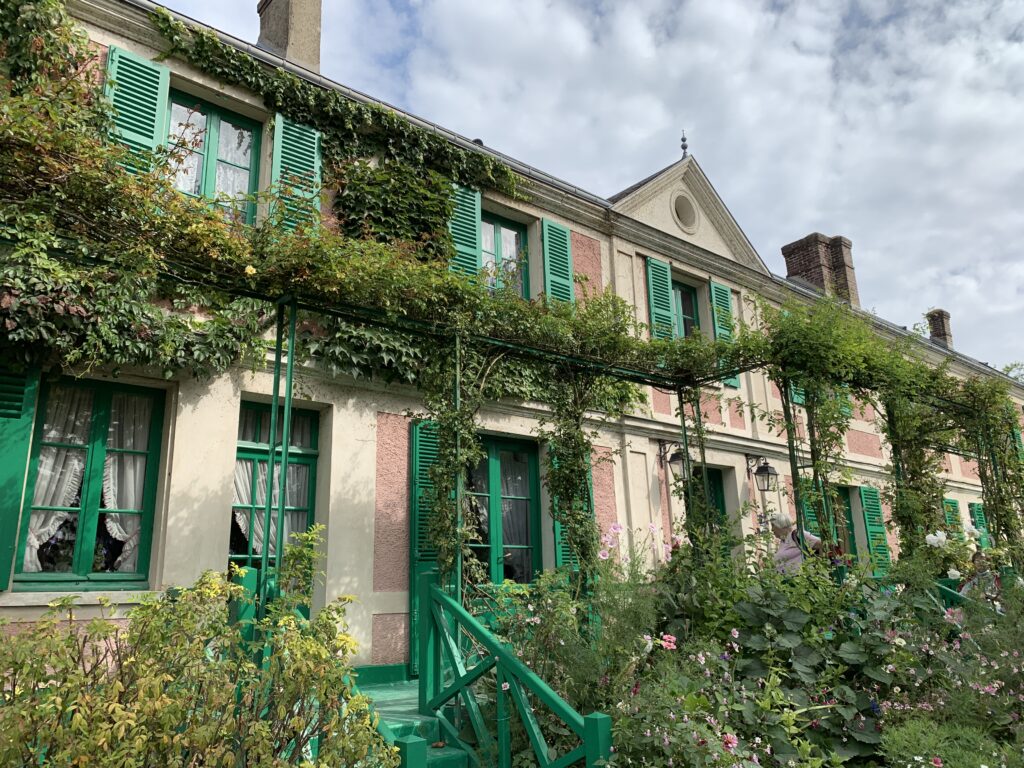


Claude Monet supervised the renovation of the house himself. He made sure that the colors of the house and its interior were matching the colors of his palette. He chose a bright pink for the outside of the house and had the windows, doors, and shutters painted in a bright green. The dining room was painted bright yellow and the main color in the kitchen is blue. On the walls are many of the Japanese prints that Monet was fascinated with and collected. Many of the rooms are open to visitors, including the salon, the dining room, the bedroom, and the studio. Inside the house, rooms have been restored to their 19th century condition, just as they were in Monet’s time. Monet’s studios are complete with reproductions of his paintings, and bedrooms are also open for public viewing.
The visit begins with his workshop where multiple paintings reproductions are exposed on the walls. This is his first workshop where he worked until 1899. A first staircase then leads into the private apartments where we discover Monet’s room, his bathroom, the room of Alice (his wife). Back to the ground floor the yellow dining room and blue kitchen are particularly memorable, one entirely furnished in bright shades of yellow, the other in tranquil blue. The furniture painted in this color was then very modern for the time. Passionate about Japan, he had covered the walls with multiple Japanese prints (211 are on display) and constituted an exceptional collection.



Many of his paintings were painted in Giverny, the village where his home is located, especially in his own gardens.
The French artist drew inspiration from his home in the village of Giverny in Northern France from 1883. Visiting his house and gardens today— now the Foundation Claude Monet Museum—you can see the Japanese bridge, waterlilies, and weeping willows that were the subjects of some of his iconic paintings.
When Monet moved to Giverny, the house had a huge garden of 1 hectare composed of an apple orchard and a vegetable garden. Passionate about gardening, Monet invested a lot in improving the garden. In 1893, he bought a piece of land at the end of Clos Normand and hijacked the little arm of the Epte to create a pond that became “the water garden”. When he created the Clos Normand he transferred all his knowledge about color, light, and perspective from his paintings to his garden. The main path of Clos Normand is covered with metallic arches on which roses grow. Straight lines and groups of colors dominate the whole garden. He built a Japanese bridge, certainly inspired by one of his Japanese prints and painted in green to stand out from the red traditionally used in Japan. It creates an oriental atmosphere via plants such as bamboo, lily flowers, weeping willows which surround the pond. At the bottom of the pond, he also planted water lilies he began to paint in 1897.
Walking through these gardens is like stepping into one of Claude Monet’s famous paintings.